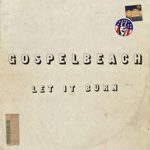Brent Rademaker, the creative force behind GospelbeacH, is not about to run from comparison. The eleven songs on Let It Burn are not only the next stage of evolution for the Los Angeles-based group- after two splendid predecessors: the loose and lax California folk rock of Pacific Surf Line and the dreamy, psych drift of Another Summer of Love. They are also the closest Rademaker’s phrasing and arrangements have yet come to confirming conclusively the influences of Tom Petty and Ray Davies. And that’s a good thing; more songwriters these days could benefit from evoking any inspirations from Petty’s Heartbreakers or Davies’ Kinks.
It’s also a darker album than the previous pair, given its share of mid-tempo melancholy as well as owning a sad footnote as the last GospelbeacH appearance on guitar of the late Neal Casal. Engineered and mixed by the group’s keyboardist, Jonny Niemann, Casal’s guitar drenches the sound; again, that’s a good thing. Especially on this straight-ahead, modern-day rock record (with some country dirt rubbed in) that feels confidently similar to those late 1970s/early ‘80s counterweights answering the decadence of disco and the anger of punk.
Throughout, Rademaker returns to small-town love, small-town lament, notably on “Good Kid,” or struts like an exile on Main on the closing “Hoarder,” especially poignant given Casal’s love for The Rolling Stones. There is also a praiseworthy contrast within the repertoire; upbeat sunshine splashes on “Unswung” and “Nothing Ever Changes” offset by the lovely deceleration of “Baby (It’s All Your Fault)” and “Fighter,” giving the album a sense of space, without lengthy jams or sprawling solos. Casal’s performance is tight and measured, smartly serving the often winding and wistful tone of Rademaker’s melody and message.
The eeriest and most haunting turn comes midway through on “Get It Back.” The mid-tempo climb opens with a departing car, and lush layers of keyboard, and follows a train carrying broken dreams going nowhere. Casal’s guitar is biting, resilient, and strong until Rademaker turns the final page, leaving us with a man dying on the stage. It’s a brave inclusion given Casal’s passing, but it’s also as revealing a Polaroid of the entire album as the actual pics in the accompanying booklet; raw snapshots of place and time.



No Comments comments associated with this post